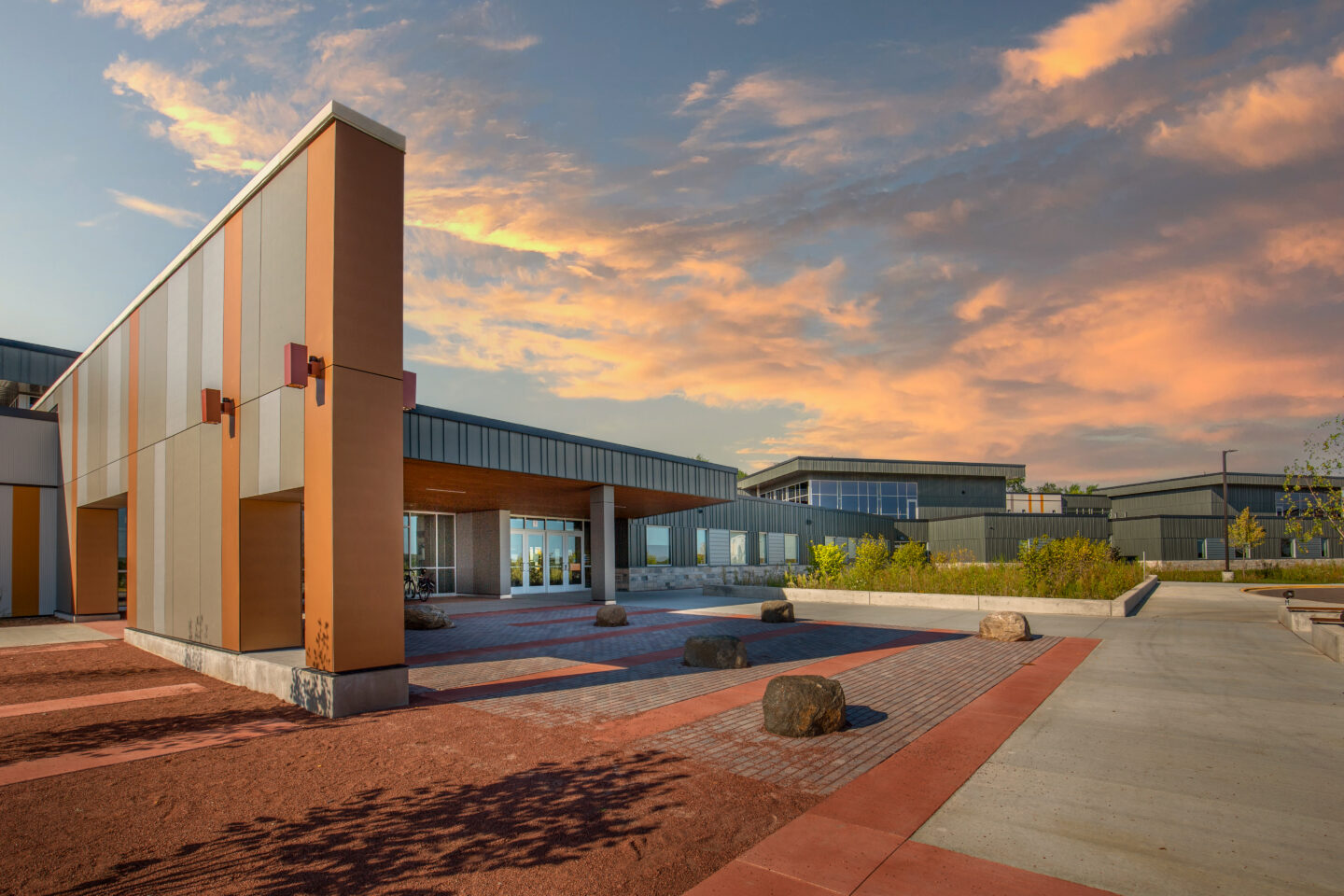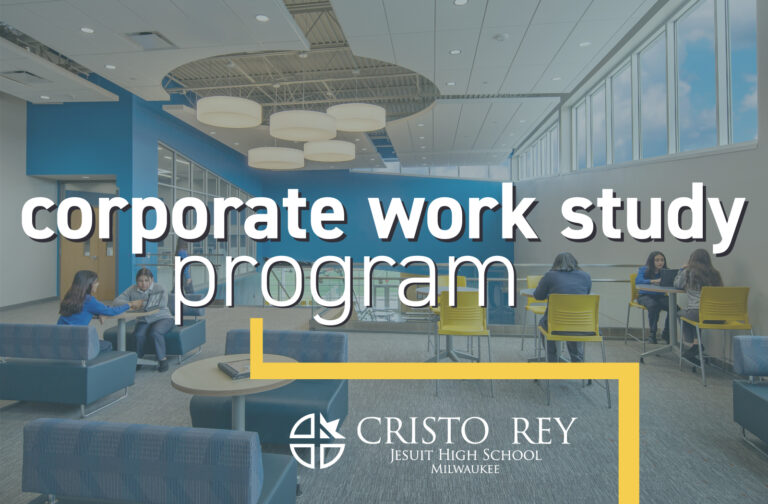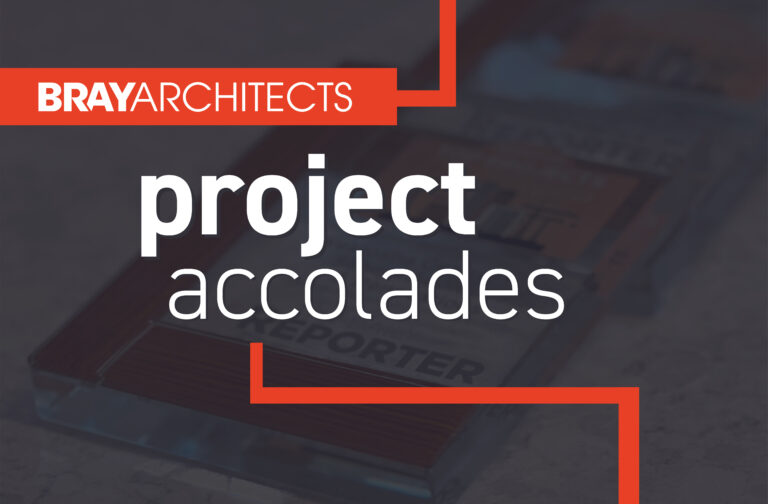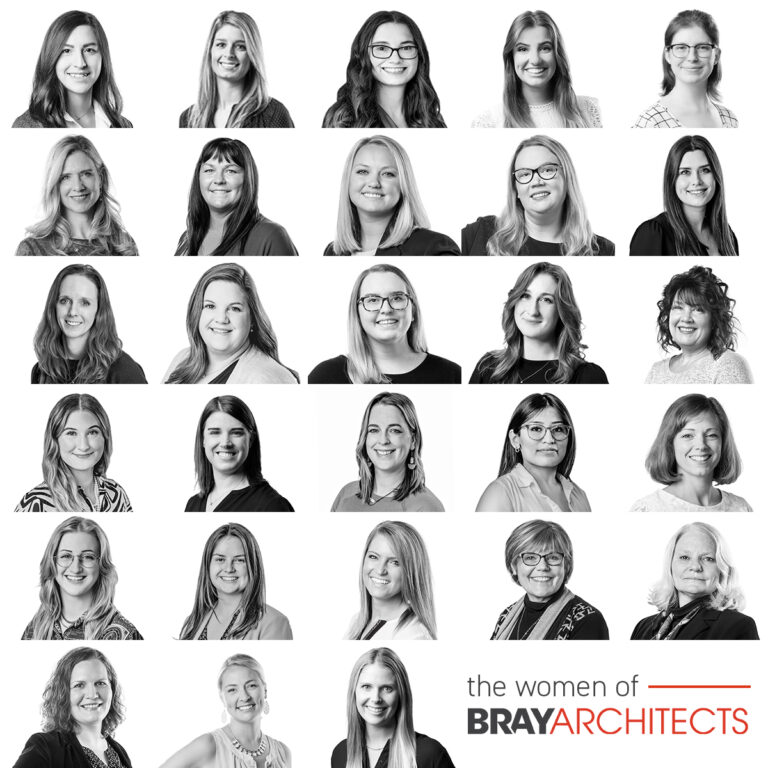Spotlight on Forest Edge Elementary School
The new Forest Edge Elementary School is an innovative K-6 school in Fitchburg, Wisconsin. As of September 2021, the building is net zero energy verified. It’s the first of its kind in Wisconsin, and the largest verified net zero school building in the United States.
This state-of-the-art learning facility boasts over 1,700 solar panels that are capable of producing 646kW of energy. There are also 90 geothermal wells that help regulate the building’s temperature.
But not only is the building sustainable, it is also a learning tool for its students. Teachers point to the themed wall graphics that highlight natural energy sources—light, life, thermal, water, and wind—to help students understand the value of renewable resources. Ample windows throughout the building allow students direct views to the solar panels, geothermal loop, and green roofs.
We asked four of the project team members—two from Bray and two from the Oregon School District—to tell us more about the journey of bringing Forest Edge to life and what makes it so special. The takeaway: with the right team and planning in place, a project like Forest Edge is possible for any public entity.
Connect with us to learn more about how we can help you with your sustainable project idea!
Video Transcript
Maria Welch
What’s really strong about Forest Edge, and I think what makes everyone so excited about this project, is that tie of education to sustainability.
I’m sure we’ve mentioned it before, but this is the first net zero school in the state of Wisconsin, which is obviously a huge accomplishment. I think what makes Forest Edge so significant and unique are the educational opportunities that we were able to integrate into the project because of its sustainability goals.
I’m Maria Welch. I’m a senior project specialist and I focus on guiding the architectural design and educational visioning.
Chris Eger
I’m Chris Eger, and I’m a project leader and architect at Bray Architects. I’ve been here six years now.
From the standpoint of sustainability, this project really lent itself to that. As I said, any project that’s around for 50 to 100 years is going to have a lot of maintenance over time. It’s going to have a lot of a costs involved running the facility, so energy efficiency is important. It’s going to have a payback.
Really, most schools should be doing this. Just from the aspect of cost—long-term costs—all of these schools are operating on certain budgets, and I believe that those budgets would be much less moving forward if they had a net zero building; if they were using the sun to power the building; if they were using batteries to store that energy; if they were using geothermal. This state is a prime state for geothermal energy. It’s not a high dollar amount at the beginning for the ROI that you get along the way.
Maria Welch
I think what we needed to always come back to was that this is a school. Yes, it’s net zero. Yes, it’s sustainable. As a design team, this was something that was always at the forefront of our mind—to make sure that we were designing this school specifically for this community.
The site was actually a legacy farmland site, and it’s part of the growing Terravessa neighborhood. All those factors compounded into the fact that we needed to be really sensitive about how we sited the building so that it was able to open itself up to the developing community and also allow access to what would be the school forest.
It really took a village to make this project what it is, and I think you can see that when you are within the community because people are able to take pride in this project because they took part in this project.
Andy Weiland
My name is Andy Weiland, and I serve as the business manager for the Oregon School District.
This has been an evolving process for our district over a good part of the 2010-2020 time frame. Early in 2010s, the board of education started to be very concerned about sustainability, climate change, and those types of concerns that we all have from a global perspective. They asked: How can we have an impact?
Kerri Modjeski
My name is Kerri Modjeski. I’m the principal here at Forest Edge. I think this is year 27 for me in the district and building number four.
Narrator
What were some of the key goals from an educator’s standpoint?
Kerri Modjeski
We absolutely wanted our teachers involved. We wanted their input. When we did that we picked teachers from across the district because we didn’t want it just to be a certain subgroup of people. We wanted a wide range of experiences, a wide range of expertise, and to make sure they had a say in how this building came together.
They brought up some of the practical issues that we face in classrooms. They did it with an inventive twist by really looking at collaborative spaces for kids and looking at how we design learning spaces that make sense for kids who need movement. They made sure we had spaces for learning throughout the whole building.
Having all those educators on the design team and involved in the process was great because we had buy-in from people, and we had representation. It wasn’t a top-down project.
Narrator
Can you talk a little bit about the significance of leveraging the building’s unique sustainable features as a teaching tool?
Kerri Modjeski
One of the unique features that kids are really mesmerized by, because it seems to happen without anybody seeing it, are the windows around here that self shade based on the sunlight. Today it’s really murky and cloudy—you can see out the windows—but on sunnier days, they shade for a couple of reasons: for temperature control and also for aesthetic appeal so that you’re not being blinded by the natural light.
I think more importantly are some of the graphics that we now have that show real time data. They show energy use over time, and you can tweak that to be the month, the day, and the year. Kids can see how that happens in real time and how their actions impact what happens to those gauges.
Narrator
It seems like there’s a perception that a lot of public entities think a sustainable project at this scale is just out of their reach. What would you tell them based on your experience?
Kerri Modjeski
I would love to see other schools do more of the same because it was doable, and it was within budget. It will pay off in rich dividends down the road.
Andy Weiland
I would say if this is important to you, which we hope it is, building a new building is the best opportunity for being able to build a sustainable building. If you can start from the ground up—don’t think of it as an afterthought—go into it right at the beginning and it’s not that difficult.
The technologies that we’re talking about are technologies that have been around for years. We have married geothermal heat pumps with photovoltaic cells, both of which we learned about in our prior projects that started in 2014.
Maria Welch
Pretty simply, there needs to be passion for it, and there needs to be vision for it. It can’t come from just architects and designers; it needs to come from the entity or the school district themselves. With Forest Edge, we certainly had that with Andy and the rest of district leadership.
I think when someone is so passionate about something like sustainability and net zero, the community will back them on that. I know that there are financial challenges, perhaps, but as design professionals, and with our consultants, we can help you get there.
Andy Weiland
It takes partners to make this happen. There’s no one single person. Bray accepted the challenge right from the get-go, and that’s important because you have to identify what your priorities are. They brought a very excited group of people to the table that knew what our priorities were, bought into those priorities, and helped us design the building.
From the engineers to the architects, everybody understood what we were trying to accomplish: a building that not only performs well environmentally but also provides an educational tool for our students.



